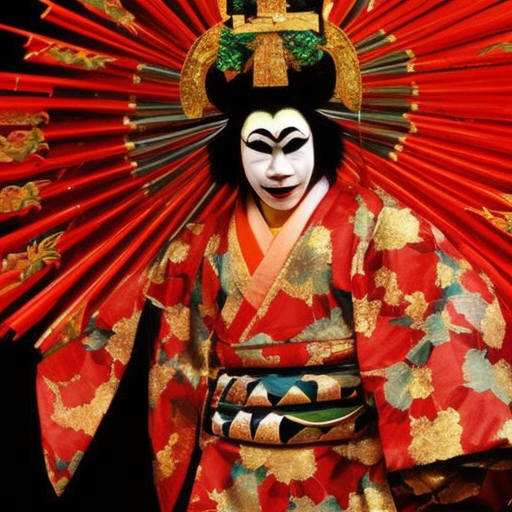Kabuki:
Kabuki is a traditional form of Japanese theater that originated in the early 17th century. It is known for its elaborate costumes, stylized acting, and the use of male actors to portray both male and female characters. Kabuki has a rich history and continues to be a popular form of entertainment in Japan.
History of Kabuki:
Kabuki was first developed by a female dancer named Izumo no Okuni in Kyoto around 1603. Okuni and her troupe performed a new style of dance-drama that was highly entertaining and attracted a large audience. However, due to its popularity and the involvement of female performers, the government banned women from performing in Kabuki in 1629. This led to the emergence of male actors who specialized in playing female roles, known as “onnagata.” Kabuki quickly became a major form of entertainment, attracting audiences from all social classes.
Elements of Kabuki:
Kabuki is characterized by several distinct elements. The first is its stylized acting, known as “aragoto” and “wagoto.” Aragoto is a more exaggerated and energetic style, often used for heroic and villainous characters, while wagoto is a more subtle and realistic style used for romantic and gentle characters. The second element is the use of elaborate costumes and makeup. Kabuki actors wear vibrant and intricate costumes, including wigs, masks, and props, to enhance their characters. The third element is the inclusion of music and dance. Kabuki performances are accompanied by live music, including traditional instruments such as the shamisen and drums. The actors also incorporate dance movements into their performances, adding to the visual spectacle.
Types of Kabuki Plays:
There are three main types of Kabuki plays: historical plays (jidaimono), domestic plays (sewamono), and dance plays (shosagoto). Historical plays are set in the past and often depict famous samurai warriors or historical events. Domestic plays focus on everyday life and family relationships, portraying common people and their struggles. Dance plays are purely focused on dance and music, with minimal dialogue. Each type of play has its own unique characteristics and themes, but all incorporate the stylized acting and visual elements that define Kabuki.
Influence and Popularity:
Kabuki has had a significant influence on Japanese culture and has been recognized as a UNESCO Intangible Cultural Heritage. Its impact can be seen in various art forms, including literature, film, and contemporary theater. Kabuki continues to be popular in Japan, with performances regularly held in dedicated theaters in Tokyo and other major cities. The audience for Kabuki includes both locals and tourists, who are drawn to its unique blend of drama, music, and visual spectacle.
Challenges and Future of Kabuki:
Despite its enduring popularity, Kabuki faces challenges in attracting younger audiences and adapting to modern times. Efforts have been made to make Kabuki more accessible, such as introducing English subtitles and offering discounted tickets for students. Additionally, contemporary Kabuki performances that incorporate modern themes and technologies have been developed to appeal to a wider audience. These efforts aim to ensure that Kabuki remains a vibrant and relevant art form for future generations.
In conclusion, Kabuki is a traditional form of Japanese theater known for its stylized acting, elaborate costumes, and use of male actors to portray both male and female characters. It has a rich history and continues to be a popular form of entertainment in Japan, with its influence seen in various art forms. While facing challenges in attracting younger audiences, efforts are being made to make Kabuki more accessible and relevant for the future.












